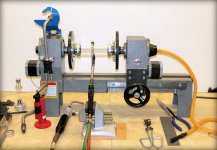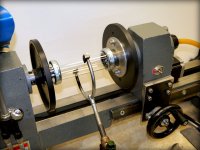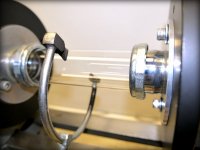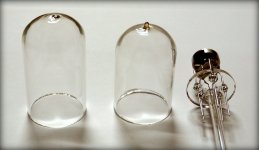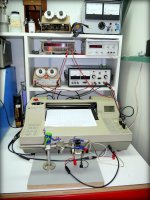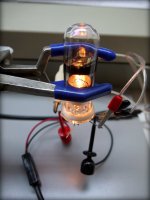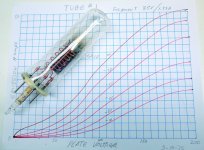Kevin - An RF bombarder is a nice instrument to have in the lab, but not really necessary. A store bought getter can be nipped at the weld pinch and then restively heated the same as the filament. Also, homemade getters are described in the DIY tube forum. The materials needed for DIY getters are readily available on eBay.
I got a chance to try out the new version of the glass lathe yesterday and was pleased with the results so far. The project was to make some envelopes for the new triode design that will be along the lines of a WE 101D electrode geometry. The lathe will make 2 envelopes at once and the process is really simple. The photos show the way the torch is mounted and aligned with the work. I'm looking forward to sealing in a stem assembly and being able to do a proper bakeout now that the tubes can be made with all glass seals.
Attachments
rif - Actually, you are contributing by just following what we're trying to do at the Workshop and then commenting if you see something interesting.
About the beer bottle; yes, it could be done after a fashion, but it would have to be the only way that you could get back from the moon or something on that level. It would probably work about as well as one of de Forest's first Audions.
About the beer bottle; yes, it could be done after a fashion, but it would have to be the only way that you could get back from the moon or something on that level. It would probably work about as well as one of de Forest's first Audions.
This is Too Cool!!! 
I have always dreamt of making my own Vacuum Tubes and CRT's since the 5th Grade.
I had read an article back then in Popular Electronics of how Ham's used to make their own components in the early 1900's.
Recently I have been (again) contemplating on making my own 10Kv Triodes to power my ESL's.
I have also wondered what kind of sound could be had using a Vacuum Fluorescent Display as a preamp.
This led me to think, maybe a simple planar design might work well.
Cheers !!!!!
jer
I have always dreamt of making my own Vacuum Tubes and CRT's since the 5th Grade.
I had read an article back then in Popular Electronics of how Ham's used to make their own components in the early 1900's.
Recently I have been (again) contemplating on making my own 10Kv Triodes to power my ESL's.
I have also wondered what kind of sound could be had using a Vacuum Fluorescent Display as a preamp.
This led me to think, maybe a simple planar design might work well.
Cheers !!!!!
jer
Kevin - The Workshop has instruments set up to be able to plot the characteristic curves of the tubes after they're processed. The photos show the setup and a typical plot from a single wing Audion type build. These tubes made good AM radio detectors.
Attachments
rif - Actually, you are contributing by just following what we're trying to do at the Workshop and then commenting if you see something interesting.
About the beer bottle; yes, it could be done after a fashion, but it would have to be the only way that you could get back from the moon or something on that level. It would probably work about as well as one of de Forest's first Audions.
Why wouldn't it work well? Would it not hold an appropriate vacuum if the bottle cap is removed and the top sealed off?
You guys should quickly incorporate if you plan on selling never seen before models! Not that is cool.
Kevin - Thanks for the positive comment! That tube was one of maybe 20 or so that I built back in the mid 90's. As can be seen by the date on the graph it was tested last year and is still a working tube. This fact should be an endorsement of how well an epoxied together tube can last. They didn't all make it, but a few are still functional.
Now that the glass lathe is up and running the DIY tubes built in the Workshop should last as long or longer than any tube made back in the early days of radio. I expect that the Workshop version of the WE 101D will perform on a par with the original design. We'll see.
Now that the glass lathe is up and running the DIY tubes built in the Workshop should last as long or longer than any tube made back in the early days of radio. I expect that the Workshop version of the WE 101D will perform on a par with the original design. We'll see.
Fantastic! I love watching the artist use all those jigs and purpose built or adapted equipment to make all the bits and pieces. I want one of those benchtop welders! I also enjoyed how he does the sweeps - nothing fancy there
Thanks for sharing!
JM
Claude Paillard's work has become something of a cult classic on YouTube with this video. I've watched is many times over the years and still enjoy his display of tools and techniques. He certainly demonstrates that DIY vacuum tubes can be a real thing.
Ron Soyland's 'Glasslinger' YouTube channel is also excellent as a source of inspiration and information. Ron's videos are far more instructional and watching him work can be a real hoot sometimes. Ron has also built almost all of his own equipment and seems to be a very talented person in many different areas.
Ron Soyland's 'Glasslinger' YouTube channel is also excellent as a source of inspiration and information. Ron's videos are far more instructional and watching him work can be a real hoot sometimes. Ron has also built almost all of his own equipment and seems to be a very talented person in many different areas.
- Status
- This old topic is closed. If you want to reopen this topic, contact a moderator using the "Report Post" button.
- Home
- Amplifiers
- Tubes / Valves
- Build Your Own Vacuum Tubes
